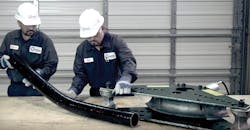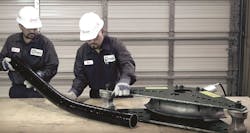If you follow a few simple rules, reinforced thermosetting resin conduit (RTRC) is easy to cut, bend, join, and bond. Here are some basic guidelines, based on recommendations outlined across three manufacturers’ websites, for you to keep in mind when working with this type of product in the field.
Field Cutting
To cut RTRC conduit in the field, you’ll just need a few supplies. Along with the usual safety gear — hard hat, safety glasses, respirator/mask, and gloves — you’ll need a contrasting colored marker and an emery cloth.
For doing the cuts, you can use any of four cutting tools: a hand-held hacksaw with a fine-toothed blade, a portable bandsaw, a chop saw with a diamond cutting blade, or an abrasive blade-cutter.
Start by measuring the conduit to the desired length, and mark the lengths for cutting using the contrasting marker. When determining your length, remember to include the additional length that will be required for insertion into couplings or termination fittings.
Make the cuts using your choice of the cutting tools above. Afterward remove stray fibers and burrs from the end of the conduit using the emery cloth.
Field Bending
To bend RTRC in the field, you’ll need a hot box and a one-shot hydraulic conduit bender, an infrared (IR) digital thermometer and a contrasting marker, along with the usual safety equipment.
As per Sec. 355.22 in the 2017 National Electrical Code (NEC), “Bends shall be so made that the conduit will not be damaged and the internal diameter of the conduit will not be effectively reduced. Field bends shall be made only with identified bending equipment. The radius of the curve to the centerline of such bends shall not be less than shown in Table 2, Chapter 9.” You should also check the manufacturer catalog to verify the specific bending radius selected.
Select the proper size hot box based on the outside diameter of the conduit and the length of the bend.
Mark the center of the bend for easy reference later.
Put the conduit in the hot box and begin heating it. Rotate the conduit by hand with the wheel on the hot box until it reaches the proper bending temperature. Refer to the manufacturer’s specifications for proper temperature range. Verify the temperature with an IR digital thermometer.
Once the conduit has been heated, carefully remove it,and put it in the one-shot hydraulic conduit bender before it cools down. Make sure the center line mark is aligned with the center of the bending shoe. Refer to manufacturer guidelines for proper shoe size selection.
Bend the conduit to the desired angle, and check the angle using the ram travel scale on the bender. After reaching the desired angle, the conduit will need to cool in the bending shoe to retain its new shape. The cooling process can be shortened by using a cool wet rag or running cool water over the bent elbow prior to removing it from the bender.
Release pressure on the bender, remove the conduit, and verify its fit/condition. Note that you might need to make slight adjustments to the bend. If so, vary the selected radius on the bending shoe or adjust the temperature on the hot box, and repeat the above process.
Joining and Bonding Connections
To make adhesive connections, you’ll need tools like a metal spatula, an adhesive gun, factory-mix adhesive cartridge and mixing tip, or cans of adhesive, a paint stick and a piece of cardboard for mixing, and an emery cloth.
Get the adhesive ready by inserting the cartridge into the adhesive gun and installing the mixing tip. Eject adhesive until it is even in color. If you’re using cans, pour one into the other, or, for smaller amounts, hand mix with the paint stick until it’s even in color.
Measure and mark your reference points. Check manufacturer’s guidelines for the proper length of conduit you need to install in coupling or
termination fittings.
Using a strip of emery cloth, sand the field-cut end of the conduit until the sheen is removed. Factory ends may be pre-sanded in most cases. Do not forget to sand the inside of the coupling.
Apply the epoxy adhesive to the spigot end of the conduit with the metal spatula. Do not apply adhesive too close to the conduit end.
Insert the conduit section into the coupling or fitting. Wipe excess adhesive from the joint. Let the adhesive set up before pulling cables. Curing times will depend on the adhesive mix chosen.
Conclusion
With these simple guidelines and a thorough familiarity with the sections of the National Electrical Code pertaining to this type of conduit, Art. 335 in particular (see The National Electrical Code on RTRC below), RTRC is a safe, convenient and reliable choice for many wiring jobs.
Sidebar: The National Electrical Code on RTRC
Article 355 of the National Electrical Code (NEC) covers the use, installation, and construction specification for reinforced thermosetting resin conduit (RTRC) and associated fittings.
Per Sec. 355.10 of the 2017 NEC, use of RTRC is permitted in:
• walls, floors, and ceilings;
• locations subject to severe corrosive influences as covered in Sec. 300.6 and where subject to chemicals for which the materials are specifically approved;
• cinder fill;
• wet locations where the RTRC is installed and equipped to prevent water from entering the conduit, provided all supports, bolts, straps and so forth are of corrosion-resistant materials;
• dry and damp locations not prohibited by Sec. 355.12;
• exposed if identified for such use; and
• underground installations (Sec. 300.5 and Sec. 300.50).
Per Sec. 355.12, use of RTRC is not permitted in hazardous (classified) locations or in Class I, Division 2 locations [except as permitted in Sec. 501.10(B)(1)(6)]. RTRC is also not permitted:
• for support of luminaires;
• where subject to physical damage;
• in theaters;
• or where subject to ambient temperatures exceeding 50°C (122°F), unless listed otherwise.
Per Sec. 355.30, RTRC must be installed as a complete system in accordance with Sec. 300.18 and securely fastened into place and supported. RTRC must be:
• fastened within 3 ft of each outlet box, junction box, device box, conduit body, or other conduit termination, unless otherwise listed by the manufacturer;
• supported per Table 335.30 or as listed by the manufacturer; horizontal runs supported by openings through framing members per Table 335.30 and fastened within
3 ft are permitted;
• expansion fittings shall be provided to compensate for thermal expansion and contraction where length change of ¼ in. or greater is expected in a straight run between securely mounted items (see Table 335.44);
• provided with a bushing or adapter where conduit enters a box, fitting, or other enclosure.
Per Sec. 355.120, each length of RTRC must be clearly and durably marked, including the type of material, every 10 ft as per Sec. 110.21(A). In conduit for use above ground, the marking shall be permanent. Markings for underground conduit must be durable enough to remain legible until installed. Markings may include special characteristics of the material.

